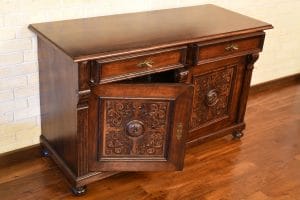Tips to Prepare your Furniture for Long-Term Storage
Maybe you’re moving temporarily out of state or moving permanently across the country but haven’t found a permanent home in your new area yet. Maybe you’re downsizing your home, undertaking a major renovation project, or just trying to put seasonal pieces such as patio furniture out of the way. Or maybe you have treasured antiques that don’t fit your home décor or quality furniture pieces you don’t use but want to save for your children.
In all these cases (and many others), your best option is to store your furniture someplace safe until it is needed again. You just have to make sure that your cherished pieces remain in good condition while they’re in storage.
Whether it’s a priceless family heirloom or an inexpensive Ikea set, when you retrieve your stored furniture you’ll want it to look and feel the same way it did before it was stored away. This, however, is only possible if your items were properly prepared and well protected before being put into storage.
Furniture can last for many decades in the right environment, but it can easily succumb to humidityHumidity is the amount of moisture or water vapor present in... More, temperature fluctuations, or physical damage if stored improperly, even for a short period of time. Needless to say, when storing furniture long term, the risk of damage is much higher and special precautions are required to ensure the safety of your cherished pieces.
Not sure how to protect furniture in storage? Here are some tips for long term furniture storage that will help you keep your items safe and sound – and out of the way – until you need them again:
Decide If a Furniture Piece Is Worth Storing

Putting furniture in storage may turn out to be more expensive than buying a new piece when you need it.
It may seem like a waste to throw away a furniture piece that is not yet broken, even if you don’t need it or don’t like it anymore. Furniture, however, takes up a lot of space and creates excess clutter in the home, so it cannot be kept “just in case someone may need it again”.
Storing furniture in a storage unit provides a good solutionA solution is a homogeneous mixture of two or more substance... More to the problem (you can keep the piece without cluttering your home), but it comes at a cost – you have to pay a monthly fee for the storage space and the costs can add up to thousands of dollars a year. Worse still, your furniture may deteriorate over time (especially if improperly stored) and become useless. Putting furniture in storage may turn out to be more expensive than buying a new piece when you need it.
On the other hand though, if you have stylish and comfortable furniture, high quality pieces, treasured family heirlooms, or precious antiques, it will make no sense to discard them just because you don’t have space for them at home.
So, if you’re wondering what to do with the furniture items you don’t currently use, take a good look at every individual piece and ask yourself:
- Is the furniture functional and comfortable?
- Is it in a good overall condition?
- Is it high quality and durable?
- Is it expensive?
- Is it an antique, a vintage item, or a collector’s item?
- Does it have any sentimental value (a family heirloom, a memento, a favorite of yours, etc.)?
If you answer “yes” to more than two of these questions, then the piece is worth keeping and you need to find a safe and efficient way to store it for future use.
Good to know: If you have a damaged furniture piece that is high quality or has great sentimental value, you don’t need to give up on it yet – find a reputable furniture restorationRestoration is the process of returning a property to its pr... More specialist in your area and ask them for a repairRepair is the act of fixing or restoring damaged property, m... More quote first. The pros may be able to fix and/or refinish your damaged piece for a very reasonable price – you’ll be able to keep your cherished furniture for a fraction of the cost of buying a new one of similar quality (not to mention that some pieces are simply irreplaceable). The skilled furniture repair experts have the specialized equipment and technical know-how to bring your damaged item back to life and ensure that it stays in excellent condition for many years to come. Just make sure you have your furniture fixed before putting it into storage.
Decide Where to Store Your Furniture
The first step to take when you need to store away some of your furniture is to find an appropriate storage place:
Attic, Basement, Garage, or Shed
If you have only a couple of items to store or if you’re storing your furniture for a short period of time (during the winter months, until your renovation project is over), it may be a good idea to keep the pieces somewhere out of the way around your home.
Attics and basements can be quite convenient – your furniture will be close at hand if you need it and you won’t have any extra storage expenses. Besides, it will be easy to move the pieces to their new location – you’ll only need to carry them up or down the stairs, not transport them to a far-off storage site.
Before taking your furniture to the attic or basement though, make sure:
- There is enough room for the pieces to be properly stored;
- The premises are well insulated – you don’t want your furniture to be exposed to moisture or extreme temperatures;
- The humidityHumidity is the amount of moisture or water vapor present in... More level is appropriate for the type of furniture you intend to store in the basement or attic – consider buying a dehumidifierA dehumidifier is a device that removes excess moisture from... More or humidifier, if necessary;
- The furniture fits through the door of the basement or attic;
- You will be able to safely maneuver the furniture along the stairs and hallways the leadLead is a heavy metal that can be toxic to humans, especiall... More to the uppermost or lowermost levels of your home;
- The furniture is properly packed for storage (see below for details).
Garages and sheds can provide a good storage solutionA solution is a homogeneous mixture of two or more substance... More for metal and plastic furniture, if space permits it. Keep in mind though that wood and leather pieces should not be kept in a garage or shed for a long time as they’re extremely vulnerable to moisture and temperature fluctuations (garages and backyard buildings are often cold and damp).
Storage Units

Heirlooms, antiques, and delicate furniture must always be stored in a climate-controlled environment as original stains, paints, and materials may deteriorate when exposed to humidityHumidity is the amount of moisture or water vapor present in... More or extreme temperatures.
If you have a lot of unneeded furniture items in your home or if you’re downsizing, moving temporarily to another place, or moving to a new city without having a permanent new home, your best bet is to rent a storage unit.
There are many good storage facilities in all parts of the country, so you should be able to easily find one with a convenient location, excellent security (modern surveillance system, fire preventionPrevention refers to actions taken to reduce the likelihood ... More system, live guards, insurance coverage, etc.), useful extra features (climate control, loading docks, etc.), and affordable prices. Storage units come in various sizes, so you can choose a space that perfectly suits your needs.
When choosing a storage unit, consider renting a climate-controlled one – especially if you live in a humid climate or an area with big seasonal temperature differences.
Temperature fluctuations and high humidityHumidity is the amount of moisture or water vapor present in... More are especially harmful to wooden and upholstered furniture – rapid changes in temperature can cause wood to expand and contract, while dampness can result in rotting, discoloration, or moldMold is a type of fungus that grows in damp or humid conditi... More growth.
Climate control will allow you to maintain a constant temperature and will ensure that your stored furniture pieces are well protected from moisture damage, moldMold is a type of fungus that grows in damp or humid conditi... More, and mildewMildew is a type of fungus that grows on damp surfaces, typi... More.
Good to remember: Heirlooms, antiques, and delicate furniture must always be stored in a climate-controlled environment as original stains, paints, and materials may deteriorate when exposed to humidityHumidity is the amount of moisture or water vapor present in... More or extreme temperatures.
Prepare Your Furniture for Storage
Now that you’ve taken all the important decisions, it’s time to get your cherished pieces ready for storage – and the better prepared they are, the higher their chance to remain in excellent shape until you need them again.
So, what is the best way to prepare furniture for storage? Follow the steps below to ensure that your furniture comes out of storage in the same condition as it was before going in:
Step 1: Clean the Items
The first thing to do when preparing furniture for storage is to give it a thorough cleaning – any dust or dirt remaining on the furniture surface may result in damage or permanent stains after a long time in storage:
- Wipe down the furniture with a dry cloth to remove dust and loose debris;
- Vacuum upholstery, work in an appropriate fabric/leather cleaner, let it sit for a while, and blot with a clean, damp cloth. Spot-clean any remaining stains;
- Apply a gentle wood cleaner on wood surfaces and wipe with a damp cloth;
- Polish any metal sections to remove existing oxidationOxidation is a chemical reaction in which a substance combin... More and delay the build-up of tarnish;
- Let the furniture sit in a well-ventilated area until it dries completely – make sure no moisture remains trapped within the item as it may cause moldMold is a type of fungus that grows in damp or humid conditi... More growth or discoloration over time;
- Apply a coat of furniture polish or paste wax on wooden surfaces to seal the wood and prevent it from dryingDrying is the process of removing moisture from materials, s... More out while in storage;
- Apply fabric protector/leather protector on upholstery.
Step 2: Disassemble Larger Pieces
Your next step is to disassemble any items you can – take drawers out of dressers, remove legs from sofas and tables, remove mattresses and box springs from beds, take headboards and footboards off of bed frames, unscrew shelves from bookcases, etc.
This will not only make your furniture much easier to pack and transport, but will also reduce the risk of damage to your items (smaller pieces are less likely to be dropped and broken or bumped against a wall or door frame and scratched or dented) and will allow you to optimize your storage space (the dismantled pieces are more compact, take up less room, and can be strategically arranged inside the storage unit to save space).
Just make sure you disassemble the furniture carefully – follow the instruction manuals, use the right tools for the job, and keep track of which part goes where. To make re-assembly easier when you remove the pieces from storage, you’re advised to:
- Take pictures of the furniture at different stages of the disassembly process;
- Put all screws, bolts, hinges, and other small parts in sealable plastic bags and attach them to the furniture they came from;
- Group the components of every dismantled furniture piece together to avoid losing or confusing any parts;
- Pack every piece with utmost care and label it properly.
Step 3: Pack the Furniture for Storage
Needless to say, packing for long term storage is the most important part of the preparationPreparation is the steps taken to ready a property, equipmen... More process – you need to provide your furniture with good protection, so that it can stay safe and sound for the entire storage period:
- Cover all the furniture items you place in storage with old sheets, blankets, drop cloths, plastic sheeting, or other appropriate covers to protect them from damage, dust, dirt, and fading;
- Use padded covers or moving blankets to cover wood furniture – the soft, breathing material will keep the wood surfaces safe from scratches and dents, prevent the furniture from accumulating dust and dirt, and allow air to circulate freely around it;
- Place extra padding around corners and edges so that they don’t scratch other items they come in contact with in the storage unit;
- Wrap legs and protruding parts – the parts of a furniture piece that are most vulnerable to breaking – in bubble wrap or soft cloths;
- Place pieces of cardboard over glass panels (like glass tabletops or glass doors), then wrap in bubble wrap to provide extra cushioning to the fragile glass elements;
- Wrap leather and fabric furniture in sheets or special furniture covers to prevent dust from settling in and reduce the risk of rips and stains;
- Hold the wrappings in place with plastic wrap or packing tape – apart from keeping dust and dirt away and holding the wrapping materials in place, plastic sheeting and shrink wrap can also protect your furniture from cold, moisture, and pests;
- Do not use plastic wrap directly on wood surfaces or upholstery – condensation may form beneath the plastic and cause wood to swell or moldMold is a type of fungus that grows in damp or humid conditi... More to develop on the furniture. Particle board furniture can be safely wrapped in plastic, as it doesn’t need to “breathe” like solid wood, leather, and fine fabrics;
- Never apply packing tape directly to the furniture – the tape should not adhere to the piece but to the material in which you wrap the furniture.
Now that you know how to wrap furniture for long-term storage, you can rest assured that your cherished pieces will be well protected and well preserved until you need them again. All that is left to do at this point is to properly pack the storage unit.
Store Your Furniture Safely and Efficiently
Proper preparationPreparation is the steps taken to ready a property, equipmen... More and packing may be of paramount importance when it comes to protecting furniture in storage, but the way you store the items matters just as much. To ensure the good condition of your pieces, you need to know how to store wood furniture, leather furniture, and other delicate furniture the right way:
- Line the floor – Do not allow furniture to come in direct contact with the floors or walls of the storage unit – storage spaces usually have concrete flooring that is permeable to moisture. To prevent your furniture from wicking moisture from the concrete and swelling, discoloring, rotting, or molding as a result, you’re advised to line the floor of the storage unit before placing your items inside – lay plastic sheeting, tarp, or drop cloth on the ground. The plastic material will act as a barrier between the floor and the furniture, blocking out moisture and buffering extreme temperatures;
- Raise the furniture off the floor – Avoid putting your items directly on the floor – raising the pieces will protect them from leached moisture and will ensure better air circulation in the storage unit. This is especially important when storing wood furniture as it needs to breathe and is extremely vulnerable to moisture. Use wooden pallets or cinder blocks to build a protective base over which your furniture will be safe and dry, no matter how long it stays in storage;
- Position the pieces correctly – It may be tempting to place couches or other long furniture items on their ends to save some space, but you should refrain from doing so. Furniture is best stored in the position that it was designed to be used in – in the same way as it would normally sit in the home. Sofas and couches are meant to sit horizontally, so they should be stored that way – placing them in another position will create extra stress on the joints (as they were not designed to support the entire weight of the piece) and may cause them to break;
- Stack the furniture properly – Be sure to stack larger and heavier items on the bottom and lighter and smaller things on the top. Do not make the stacks too high as that can result in objects falling and getting damaged. Avoid placing heavy or sharp items on top of upholstered furniture and delicate wood furniture;
- Organizing the storage unit strategically – Make a plan of how to arrange the items in the storage unit before you start placing them inside – organize the space in a meaningful, systematic way and be sure to allow for easy access. Place the largest pieces at the back and near the walls and arrange smaller items in front. Leave aisles between the items, so you have access to the back and sides of the storage unit. Be careful about where you place the furniture in regard to other items – storing gardening supplies next to wood furniture, for example, is a very bad idea;
- Leave space between the items – Be careful not to overstuff the storage unit – you may easily damage your furniture pieces if you bunch them too closely together. As you try to cram more and more items inside the storage unit, you risk knocking things over, bending pieces, and causing other damage. Besides, air won’t be able to flow freely around the furniture and help regulate the temperature and humidityHumidity is the amount of moisture or water vapor present in... More levels in the storage unit;
- Avoid pests – Most storage facilities have appropriate pest control, but it’s still advisable to take some precautions against insects and rodents – make sure you don’t leave anything perishable in the storage unit that may attract bugs or critters, never use cardboard boxes that came from a grocery store, carefully clean food and beverage spills from furniture (and anything else) you put in the storage space, etc.;
- Maintain optimal temperature and humidityHumidity is the amount of moisture or water vapor present in... More levels – As already mentioned, furniture is best stored in a climate-controlled environment, so that it is protected from high humidityHumidity is the amount of moisture or water vapor present in... More (that may cause swelling, rotting, or moldMold is a type of fungus that grows in damp or humid conditi... More growth), dryingDrying is the process of removing moisture from materials, s... More out (that may cause the wood to crack or splinter), extreme heat (that may warp or melt certain materials) and extreme cold (that may cause some items to become frigid and more vulnerable to cracking and breaking). So, if you’re storing furniture in a storage unit, it would be wise to opt for a climate-controlled one. If you’re storing some pieces in your home, make sure that the space you choose is well-insulated, well-ventilated, and doesn’t get too hot or too cold.
The above tips for long-term furniture storage will help you ensure the safety and excellent condition of your stored pieces. Despite your efforts, however, your furniture may not look as good as you want it to when you take it out of storage. In such a case (or if any of your items sustained some surface damage while in storage), it will be best to hire experienced furniture refinishing professionals to restore the piece back to its original condition. It will look and perform as good as new and you will be glad that you decided to keep it, despite the challenges of storing furniture long term.












